Davis Island: A Confederate Shrine, Submerged

“It would be a shrine of the nation—if the South had won the war,” insisted the man offering admission to the Old Courthouse Museum in Vicksburg, Mississippi, which advertises its collection on its website by highlighting “Confederate flags, including one that was never surrendered.” It also boasts “the tie worn by Jefferson Davis at his inauguration as Confederate President.” The shrine-that-wasn’t was Brierfield, Davis’s plantation, once located some fifteen miles to the southwest. Brierfield was one of several plantations—including those of Davis’s eldest brother, Joseph Emory, and Mississippi Governor John A. Quitman—located on what was known then as Davis Bend, an eleven-thousand acre peninsula of rich bottomlands, bounded on three sides by the Mississippi River. In the middle decades of the nineteenth century, Davis Bend, with its fields of flowering cotton, sat squarely on what historian Walter Johnson terms “the leading edge of the greatest economic boom the world had ever seen.”1 It was there that the Davises made their fortunes. It was there, along the hedgerows of his wife’s garden, that Jefferson Davis was presented with the news of his election as his new nation’s president. And it would be there that tourists would meet interpreters in costume dress replaying the scene daily—if not for Gettysburg, Vicksburg, Appomattox.
Or so I was told—not just by the Old Courthouse docent, but again by my host on my trip to the site where Brierfield stood. The premise carried the usual seduction of a pithy counterfactual. But it did not stand to reason. After all, the conditions of Confederate surrender included no ban on Confederate shrines. One can go to Richmond and visit the White House of the Confederacy, out of which Davis operated. Or one can gaze up at Davis atop a horse carved in light relief into the bald face of Stone Mountain, just outside of Atlanta. Or one can stand in the shadow of the obelisk—the world’s third largest—marking his birthplace in Fairview, Kentucky.
So why no shrine at Brierfield? Visiting today, one cannot help but think it has much less to do with the Union Army and much more to do with the Mississippi River. I didn’t see the river once on my stay, but its damp shadows were everywhere: the thin lake, tracing the old riverbed, we had to cross by ferry; the patch of mud, interrupting the sandy road, in which I got our pickup stuck; the stain of the water line two feet from the floor of the lodge that is already hoisted ten feet above the ground. Proximity to the river had drawn Joseph Davis to purchase land for himself and his brother in 1818, but since then the river has been more successful at chasing people away.

What remains of the headstone marking the grave of Joseph Davis, who purchased an immense tract of rich Mississippi bottomland with abundant river frontage in 1818. He sold thousands of acres off to friends and gifted what would become Brierfield to his youngest brother, Jefferson. Benjamin Montgomery, who managed Joseph’s plantation while enslaved and bought and ran both plantations for twelve years after the war, is also buried on Davis Island, but his grave has not been located. (Hamilton, 2014)
In March 1867, after a particularly snowy winter and wet spring in the Ohio Valley, the river leapt its banks and took a short-cut across the neck of Davis Bend, creating the island it is today. The 1867 flood was not the problem of Jefferson Davis, who was in prison, or Joseph Davis, who was in his eighties and residing in Vicksburg. Left fighting the rising waters were Benjamin Montgomery, a man enslaved by Joseph Davis for 29 years, his family, and the company of former slaves with whom he had succeeded in obtaining a $300,000 nine-year mortgage from Joseph Davis for the Davis family plantations. They struggled with shovels and mules to make their sixteen miles of levees hold against high water in 1867, 1868, 1871, and 1874. They even went so far as to take on another $100,000 of debt to acquire the neighboring Ursino plantation from its bankrupt owner who refused to maintain his own levees. But though Montgomery & Sons succeeded in creating one of the most profitable cotton operations in the state in the early 1870s, the battle against the river, and a depressed cotton market, led the younger Montgomerys and their associates to seek out drier ground north in the Delta and in western states after their father’s death in 1877.

An early twentieth-century tenant farmer home. The Davis heirs struggled to retain tenants, in part because of frequent flooding. (Hamilton, 2014)
The land reverted to the now-free Jefferson Davis, who then saw his profits erode with his levees, and after a sixteen-year stretch featuring nine springs of destructive floods, his heirs ceased crop productions and leased their holdings for pasturage. The 1922 flood brought water six feet deep into Brierfield, leading them to invest in raising the mansion up onto brick columns, which managed to save it from the infamous 1927 flood—but not a chance fire in 1931, which consumed all but its stonework. Yet the Davis family retained the ruins and the property as a family shrine, if not a national one, until 1953, when they sold it to two men who flipped it the next year to a lawyer in Vidalia, Louisiana who had invested in the region’s oil and gas industry—the cotton boom of its day—at a particularly fortunate moment. He and his family chose a relatively flood-proof land use: hunting. For decades, wealthy Americans and Europeans had been scooping up abandoned plantations along the Mississippi to repurpose as hunting grounds for the enjoyment of their private clubs. On Davis Island, forty years of light use ushered in revivals of briar, forest, alligators, deer, and even bear.
The Vidalia lawyer’s heirs are proud custodians of the historic sites but they are not interested in being groundskeepers. My gregarious host turned sheepish when we approached the Davis Family cemetery, its headstones having been rocked this way and that by flood after flood and cocooned in thick grass. “I’m sorry we haven’t kept it up,” he apologized to me—or really, it seemed, to all historians, all lovers of the past. But there is no one to tend these sites for. This is no shrine of this nation or any other. They sell no tickets. Rather, one must be invited onto Davis Island, and such an invitation is hard to come by, as the Brierfield Hunting Club has no website, no email address, and no phone number.
The club’s concern is not preserving history, but conserving deer. In this, too, water presents obstacles. In response to the 1927 flood, the Army Corps of Engineers constructed massive levees up and down both sides of the Mississippi River. But the Corps surveyors judged Davis Island too small and insignificant to barricade. That left the land not just unprotected but newly threatened, as the Corps levees meant higher flood levels for the land in between. In 1983, water covered all but two percent of the island. In 2011, its highest point sat beneath eight feet of water. These waters have repeatedly rushed into the elevated, and in some cases elegant, hunting lodges, forcing costly restorations. The deer survive only by swimming to dry land, but the exertion can claim part of the herd and suppress reproduction rates, and the sodden ground to which they return can be brimming with deadly anthrax spores.

The sixty-foot levee raised by the Army Corps of Engineers on both sides of the river in the wake of the 1927 flood, leaving Davis Island (down to the right) susceptible to even higher waters. (Hamilton, 2014)
The great riches of this landscape—its cotton, its game—are, and have long been, threatened by the marauding Mississippi. So it is with its historical riches. The outcome of the Civil War transformed the nation, and the succeeding battles about what it all meant have been present in American life ever since, with combatants erecting shrines—in stone, in print, in celluloid, in law—and tearing them down. Yet Brierfield was lost to neither the war nor the culture wars that followed, but to the river.
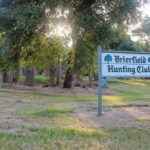
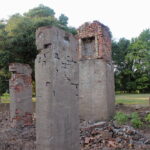
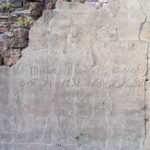
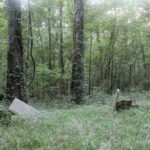
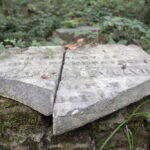
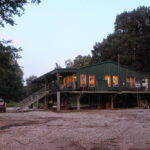
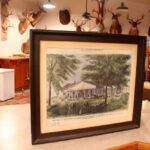


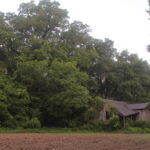

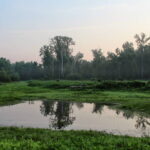

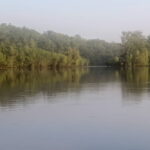
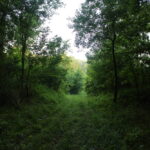
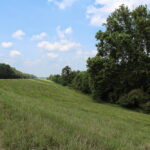
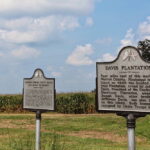
Brian Hamilton is a Ph.D. candidate in the History Department at the University of Wisconsin-Madison writing a dissertation on black agricultural expertise in the United States before and after Emancipation. He is also the lead author of Gaylord Nelson and Earth Day: The Making of the Modern Environmental Movement. Website. Twitter. Contact.
Walter Johnson, River of Dark Dreams: Slavery and Empire in the Cotton Kingdom (Cambridge, MA: Belknap Press, 2013), 149. ↩
Beautifully photographed and written.
thanks for the very interesting research and commentary regarding the unfortunate circumstances of Brierfield. Was watching The civil war in color on History2 channel and they showed a pic of Brierfield and that is what led me to your site.
Thanks for reading!
Is this similar to the loss of Forts Henry and Donelson to the floodwaters of the Mississippi and the Tennessee Rivers. Those pivotal battlefields are submerged due to the careless whims of early 20th Century dam and dike construction. What an unfortunate loss.
Thanks for your comment. I hadn’t heard these stories, but they do sound similar. I wonder if there were discussions within or surrounding the Army Corps of Engineers about the risks dams posed to historic sites. That would be a fascinating research project!
What’s most noteworthy about the Davis Bend narrative is Benjamin Montgomery, indeed. What a remarkable accomplishment to have come out of the peculiar institution of slavery to attain the ultimate prize of ownership, for over 12 years, the very plantation(s) and home front on which he was enslaved by of all people Jefferson Davis, the President of the Confederacy and his brother Joseph Davis. What an accomplishment!
You said it, Ms. Turnipseed. The Montgomerys’ story has a lot to teach us about this era. As do you! I hope everyone keeps an eye out for your important work on Delta cotton pickers.
I have studied some of the accomplishments of Benjamin Montgomery. He and his family were well thought of by the Davis family, and the Jefferson Davis family and the Montgomery family periodically communicated via letters during the post-bellum years. In one of these letters, Jefferson Davis praised B. Montgomery for his efforts and answered some questions Benjamin Montgomery had asked him about farming issues on the island. It was several years ago when I read this particular letter, so I do not remember any specifics.
Thanks for your comment, Mr. Grady. There were, in fact, hundreds of letters exchanged between Benjamin Montgomery and Joseph Davis. Many are today available the University of Mississippi and the Mississippi Department of Archives and History. They reveal the deep knowledge the Montgomery and their associates possessed about agricultural production along the Lower Mississippi River, more knowledge than that of the Davis bothers. Benjamin Montgomery’s relationship with Joseph Davis after the war was beneficial (and profitable) to both men, but his relationship with Jefferson Davis was contentious. Jefferson Davis, with scant evidence, claimed to hold title to a portion of the land his brother sold to Montgomery and successfully sued to force the Montgomerys off of it. Jefferson did not share his brother’s recognition of the agricultural expertise of the former slaves, writing of Davis Bend in 1868, “It is no doubt that the property is too large for the administrative capacity of a negro.”
very much enjoyed reading this .
Well written I enjoyed reading this article,Jefferson Davis is a relative of mine and reading this is so great. Shame the river has ruined the graves of so many,
May I with permission copy this and place it on my very large family tree of Davis’s.
Please go right ahead. Thanks for your interest!
Very well written and informative. Your photographs are amazing! With your permission may I use several of the cemetery markers in my family tree? Did you,
by chance, take any additional photos of other cemetery markers?
Thank you for your kind words. If you contact me at the email address linked to in my bio above, I’d be glad to send you what I have.
A very concise and well written article. As an SCV member, I can appreciate the trials of trying to keep the graveyards maintained near these rivers.
Thank you for the article. Being that I am a descendent of Joseph Davis it is much appreciated!
Amazing article! I know this is a couple of years late, but i stumbled upon this while doing research. I’m a 6th gen louisianian, from the parishes immediately opposite Davis Island. Before that my family resided in the other side in Mississippi. My father used to occassionally be invited to hunt on Davis Island, but i never did. This area was hit hard by the civil war and not much survives, what little was left became a victim of the changing economic landscape and general apathy and poverty. To me your photos capture the one abiding thing, the haunting natural beauty of this area. It is reverting to the state it probably was when Joseph Davis first saw it.. its a hauntingly beautiful area, thank you again. And thank you for telling the story of Davis former Slave who along with his family managed to rise up from a most abject and detestable state of life to become masters of their own fortunes.
Mr. Hamilton,
I just recently discovered that I am a descendant of Mr. Benjamin Montgomery. Thank you for the insight. I truly would like to obtain a copy of those letters.
You’re very welcome, Ms. Jackson. Thanks for reading. A portion of the Montgomery-Davis correspondence has been digitized by the University of Mississippi and is available here: http://clio.lib.olemiss.edu/cdm/search/collection/civil_war/searchterm/joseph%20e.%20davis/field/all/mode/all/conn/and/order/identi/ad/asc
Were you able to locate the site of the Joseph Davis house on Hurricane Plantation, further to the west of Brierfield? Are there any remnants of it to be seen today?
I gave it my best, but ended up getting a very nice truck (belonging to someone I had only just met) very stuck, leaving me out of cell range, several snake-filled miles from camp.
Midcentury accounts describe an extant foundation, but the landowners I spoke with hadn’t seen it.
Thanks for the quick response. I grew up in Vicksburg, and share the same June 3rd birthday as Jefferson Davis, but I’ve never been able to get an invite to Davis Island. Your article provided some great insight and fine photos. Thanks.
I enjoyed reading your article. I am a descendent of Joseph Davis and was looking up some information online when I stumbled on the article. If there is ever a chance to get to Davis Island to see the ruins and the cemetery, I would love the opportunity.
I never tied the name Jefferson Davis, just thought it was some local people that named it. I live in Vidalia and you didn’t mention the lawyers name. I hunted and fished on Davis Island a number of years ago by way of a man that was employed by J.M. Jones lumber company of Natchez, Miss. Do you know how Jones Lumber fit in?
I WAS BORN ON DAVIS BEND MISSISSIPPI IN 1943 .we the Barnett family left the island in 1958 and move to newton Louisiana in 1958